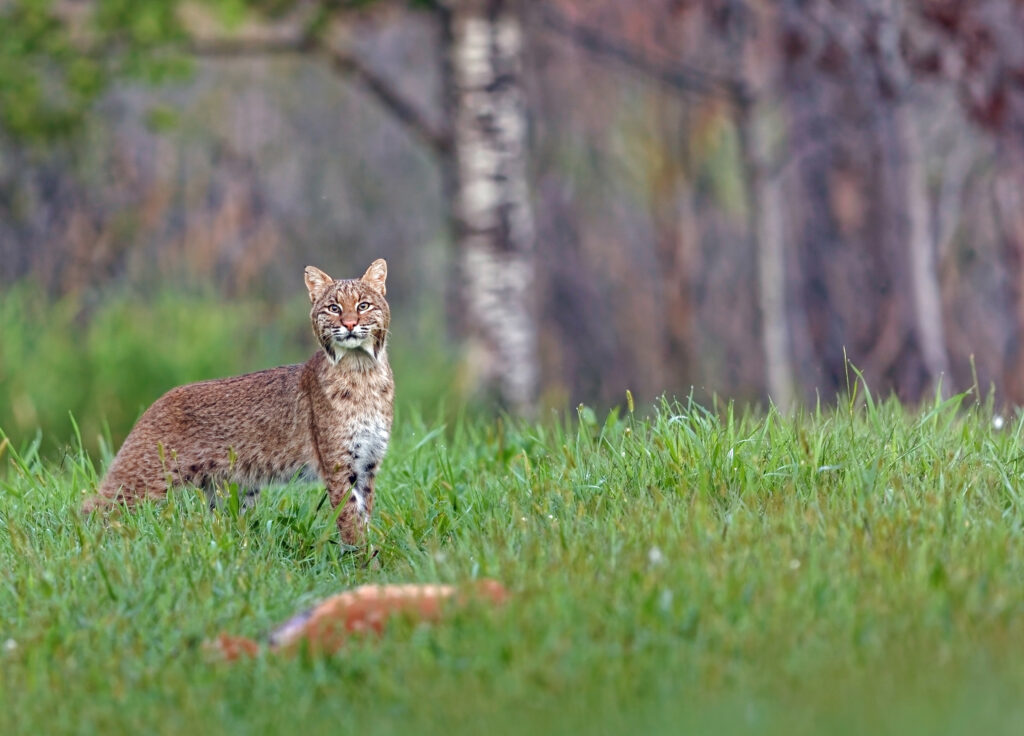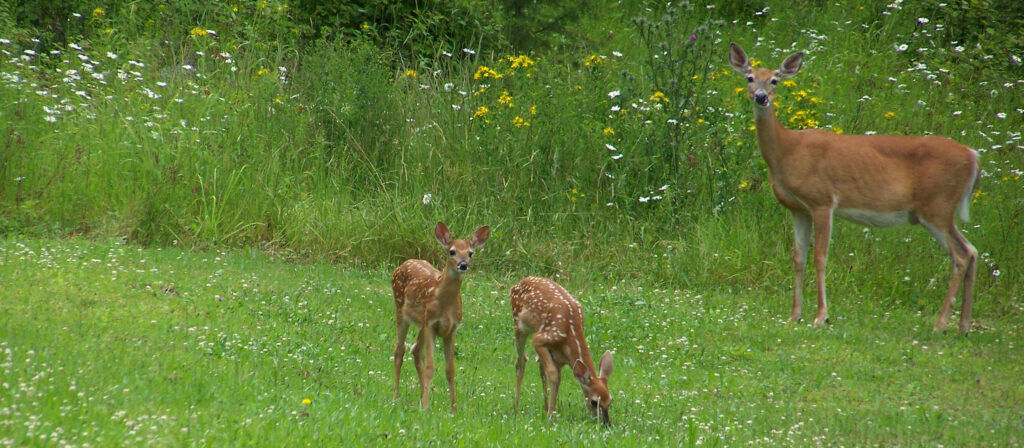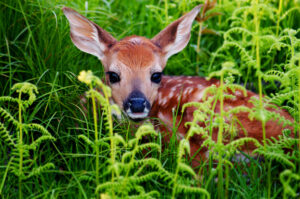As hunters and gamekeepers, we’re rooting for the younglings. We want them to grow up and one day sport a set of handsome antlers, or produce fawns of their own. But in the wild, their chances of making it through the first year of life are, at best, 50:50. Fortunately, there are a few things we can do to improve a fawn’s survival odds.
Predator Control
Most people automatically turn to predator control when there is a question about fawn mortality and recruitment. There’s no question, predators have a profound effect on productivity. A U.S. Forest Service study in South Carolina found that coyote predation accounted for between 46 and 84 percent of all deer mortality; and somewhere between 47 and 62 percent of all fawns succumbed to coyote predation, most within the first three weeks of life. Another study in southwestern Georgia showed the percentage of deer hair in coyote scat almost doubled during the fawning season. Researchers at Auburn University found coyote predation to be “the leading cause of fawn mortality” in suburban areas around Auburn, Alabama. And a Pennsylvania study found black bears to also be a significant predator of fawns.

Intuitively, you would think predator control would definitely improve productivity. And it can, if done correctly. If not, you might end up doing more harm than good.
Because they’re a big game species in some states and protected in others, there’s not much you can do about bears. Bobcats most certainly kill their share of fawns too, but probably aren’t numerous enough to have a substantial impact. So most of the control efforts are directed toward coyotes. Few deer hunters ever pass up a serendipitous shot at a coyote, and many well-meaning land managers apply trapping and other methods to try and keep coyote numbers down. While it’s gratifying, it may not always have the desired effect.
There have been numerous studies on coyote control, most of which showed it is extremely difficult to legitimately reduce coyote numbers, and therefore predation over the long term. Even then, it usually involves expensive and labor intensive efforts. Furthermore, recent studies have shown that efforts to reduce coyotes could actually have the opposite effect.
Nature abhors a “vacuum” and empty spaces are very quickly filled, especially when filled with their food. Family groups of coyotes establish and defend their territory. Remove one or both of the adults and others quickly move in and fight over that territory. Removing alpha males or females also makes a particular area more inviting for transients.
So far only one remedy seems to work best for predator control, and it’s a short term solution. There is evidence that intensive trapping and removal just prior to and during the spring fawning season can have a positive effect on recruitment rates. It is expected that you’ve got to remove at least 75 percent of the coyotes present, and you’ll have to do it again the following spring… and that still may not be enough.
Delaware researchers found, even in the absence of predators, the survival estimate for fawns after 90 days was only 45 percent. There, fawn deaths were linked to natural causes like starvation, disease or birth defects. And that rate was toward the lower end of the range of estimates from other studies conducted over the past 15 years where predators were present. Clearly, there must be other measures beyond or besides predator control…and there are.
Habitat Management
If you’re already actively managing your land then you’re probably well on your way to better fawn survival. A Pennsylvania study found that fawns on agricultural land (including food plots) have a better chance of surviving to six months of age than those in forested landscape by a factor of about 5 percent for every 10 percent increase in agricultural land! But wait; there’s more.
 White-tailed deer are considered an “edge species,” preferring the ecotone or forest fringe. One reason is because this zone receives more sunlight, promoting more herbaceous growth. But it’s not the only reason. Open fields; at least in the case of agriculture and food plots provide food, but often lack cover, the same type of cover that is typically densest in the ecotone. Not unexpectedly, a study by Dr. Will Gulsby, at Auburn, found that fawns in areas with the least amount of edge habitat were more than twice as likely to be eaten by a coyote (the leading cause of fawn mortality) than those in areas with more edge availability.
White-tailed deer are considered an “edge species,” preferring the ecotone or forest fringe. One reason is because this zone receives more sunlight, promoting more herbaceous growth. But it’s not the only reason. Open fields; at least in the case of agriculture and food plots provide food, but often lack cover, the same type of cover that is typically densest in the ecotone. Not unexpectedly, a study by Dr. Will Gulsby, at Auburn, found that fawns in areas with the least amount of edge habitat were more than twice as likely to be eaten by a coyote (the leading cause of fawn mortality) than those in areas with more edge availability.
While large, agriculturally efficient feeding plots do benefit deer, you should also include smaller plots in your management plan as they offer more edge cover and greater overall habitat diversity. This can be further magnified by building irregularly shaped plots, the type most often used as hunting plots. But don’t stop there.
Yet another step you can take to improve productivity, and possibly put money in your pocket, is timber stand improvement. In a mature forest, there is about 50-100 pounds of potential deer food per acre. Early successional forests, like those remaining from a selective cut, can produce upwards of 1,000 pounds of forage per acre. Add in prescribed burning and you can boost that to 1,500 pounds per acre. And, that dense cover makes it easier for fawns to avoid and escape predators.
In addition to the economic benefit you might gain from timber sales, you also gain money and labor costs by leaving the tractor in the barn compared to having to disk and plant a food plot. It’s a very cost effective way to provide both, more food and cover.
If you aren’t actively harvesting timber, you can still improve fawning cover within the forest by creating small openings, hinge cutting, and other methods to thicken the undergrowth. Reducing the canopy will allow more sunlight to reach the forest floor producing denser cover, not to mention more food.
Another potential place for fawning cover that requires little or no maintenance is to fallow old fields. This is the philosophy behind the Conservation Reserve or Set Aside programs. You don’t need to plant every acre of open ground in food plots. Leave some as it is, and let natural succession do the work. An exception to this might be something like a monoculture of fescue or Bermuda grass. There, you might need some herbicide, fire or even disking to stimulate the growth of native plants.
Herd Management
Improving the age structure and buck to doe ratio of deer herds is another cornerstone of quality deer management. As they’re the ones most directly responsible for producing fawns, let’s start with the does. Balancing sex ratios and keeping the herd balanced with habitat often involves removing a certain number of does. Fewer mouths mean more food for those that remain. The question then, becomes which does to remove, and when. As you would expect, and the research bears out, mature does both, produce and successfully rear more fawns. So, selectively protecting older does is also more likely to improve fawn survival.

Managing males can also improve fawn survival and overall productivity. Just as older does are more successful at rearing fawns, older bucks tend to be more effective at breeding does, which means better productivity. Another effect is a more intense and synchronous rut. This, in turn, leads to a more synchronous fawn-drop – called “predator swamping,” it serves to overwhelm the area with so many fawns over a shorter period that the predators can’t hone-in on nearly as many.
Timing of doe removal also factors into the mix. Some hunters may be concerned that removing does before the rut reduces the number available to breed. But if your population is healthy enough to remove some, it may actually be the best time as far as the rest of the herd is concerned. Fewer does means more competition among bucks, which can further shorten and intensify rutting activity. It also means fewer mouths so more food remains for the rest of the herd.
More important is the energy equation. Energy is transferred from the sun to plants and from plants to deer. In order to survive, deer must manage their “energy budget,” which means taking in more than they spend. Part of the surplus goes to the individual deer for maintaining body function. The rest goes into the population through reproduction.
 Both bucks and does expend a certain amount of energy toward breeding. By killing a doe after the rut, you remove both her energy and all the energy invested in her by the buck that bred her. If you kill her before the rut, you remove only her energy from the population. Furthermore, that buck will exert all his surplus energy toward does that will likely still be around to produce fawns the following spring. That sounds like a much better investment in your population to me.
Both bucks and does expend a certain amount of energy toward breeding. By killing a doe after the rut, you remove both her energy and all the energy invested in her by the buck that bred her. If you kill her before the rut, you remove only her energy from the population. Furthermore, that buck will exert all his surplus energy toward does that will likely still be around to produce fawns the following spring. That sounds like a much better investment in your population to me.
Conclusion
If you haven’t already figured it out by now, none of these variables is independent. Habitat management, herd management and predator control are all interrelated. By improving one, in many cases you enhance the others, so that the value of the whole effort becomes greater than the sum of its parts. The more you can combine one variable with another, the better your results will be. The end result is greater productivity, more, healthier deer and a higher quality hunting experience.










